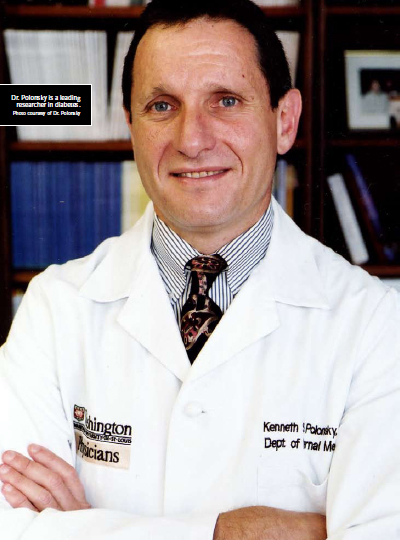Today’s Machining World Archive: March 2010, Vol. 6, Issue 02
by Noah Graff

Dr. Kenneth Polonsky is the Adolphus Busch Professor of Medicine, a Professor of Cell Biology and Physiology, and the Chairman of the Washington University Department of Medicine. He began doing diabetes research 32 years ago at the University of Chicago and is today considered one of the most prominent doctors in the field.
Give me a brief definition of diabetes, and tell me what the difference is between type 1 and type 2.
KP: Diabetes a disease in which the body either doesn’t produce enough insulin or it doesn’t respond to normal amounts of insulin, which you need to keep blood sugar under control. As a result, the blood glucose level in the bloodstream rises. This increase in glucose is the hallmark of diabetes.
Type 1 diabetes is an autoimmune disease that occurs predominantly in children, in which there is destruction of the cells that produce insulin, the pancreatic beta cells, by the body. So the patients who have this disease have destroyed their own beta cells.
In type 2 diabetes, the body doesn’t produce enough insulin and doesn’t respond to the insulin that is produced. The failure to respond to insulin is called insulin resistance. Type 2 diabetes occurs mostly in older people, although it’s occurring younger and younger. It’s becoming quite common now in teenagers who are sedentary and overweight.
Thirty years ago, did you expect our knowledge and treatment of diabetes would be where it is today?
KP: I don’t think I had very clear expectations. There have been a lot of advances in our knowledge and some advances in treatment. But it’s a disease that has become more and more common, and we’ve been unable to prevent that from happening. There’s an underlying genetic predisposition, but it’s mainly related to the fact that we’re getting more and more overweight.
How good are the drugs we have today for treating diabetes?
KP: There are a number of very good drugs. But the drugs are not as effective as changing your lifestyle. If we could get everybody to lose weight, exercise more and eat in more modest amounts, we would not entirely eliminate diabetes, but could eliminate probably two thirds to three quarters of cases.
Is there any alternative medicine for diabetes?
KP: We’ve actually done some research on ginseng. Ginseng has been used all over the world, but particularly in Korea and Japan, to treat a variety of ailments including diabetes. [Our studies found that] it worked in mice but it didn’t work in humans. I don’t think there’s any really good [scientific] evidence that alternative medicines prevent diabetes or can treat it.
Can a person get rid of diabetes once they have it?
KP: Sure. If you’re very overweight and you really lose weight and keep it off you can get rid of [type 2 diabetes]. You may not be able to get rid of it permanently, but you could certainly make it go away for prolonged periods of time. It may come back when you’re much older, but it will come back in a milder form. You can postpone it coming back for 20 or 30 years.
Has anyone cured type 1?
KP: Curing type 1 is not easy. I don’t want to say it never happens, but it would be an extraordinarily uncommon circumstance.
What are you most excited about as far as diabetes research on the horizon?
KP: I think the most encouraging thing is that we’re relatively close to very important understandings of why we develop the disease. We’ve understood it at a certain level, but now we’re going to be able to understand the specific proteins that are abnormal, the biochemical pathways that are involved and the genetic abnormalities that are responsible. It wouldn’t be surprising if within the next 5-10 years, at least in understanding how the disease develops, there were major breakthroughs. That’s likely to be the first step in developing better treatments.

1 Comment
Pingback: One on One – Dr. Kenneth Polonsky | Todays Machining World